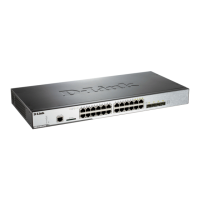DWS-3160 Series Gigabit Ethernet Unified Switch Web UI Reference Guide
337
• Global – Receive the basic and advanced global settings.
• Discovery – Receive the L2 and L3 discovery information, including the VLAN
and IP list.
• Channel/Power – Receive the RF management settings.
• AP Database – Receive the AP database settings.
• AP Profiles – Receive the AP profiles settings.
• Known Client – Receive the known client database settings.
• Captive Portal – Receive the captive portal information.
• RADIUS Client – Receive the client RADIUS information.
• QoS ACL – Receive the QoS access control lists settings.
• QoS DiffServ – Receive the differentiated classes, services and policies.
If the switch has not received any configuration for another switch, the value is
Display the last time this switch received any configuration data from a peer switch.
After clicking the AP Hardware Capability tab, few more sub-tabs appears. Click the Summary tab, and the
following page will appear:
Figure 2-5 AP Hardware Capability - Summary window
The fields that can be displayed are described below:
Parameter Description
Total number of entries displayed in the table below.
Display the AP hardware type.
Hardware Type
Display a description of the platform and the supported IEEE 802.11 modes.
Display whether the hardware supports one radio or two radios.
Display the type of software the hardware requires.
Dual Boot
Display whether this AP hardware type supports dual boot.
On dual boot APs, if the AP code is corrupted during the code upgrade process
due to a power failure or unexpected AP rebooting while the AP is writing to
NVRAM then the AP is able to come up using the old image.

